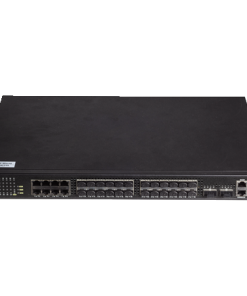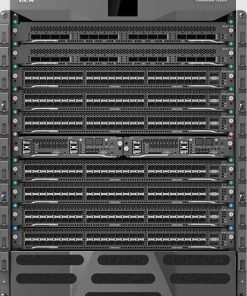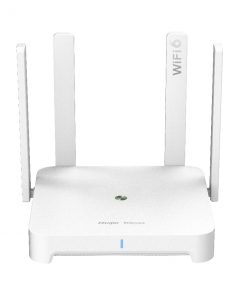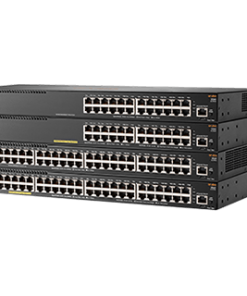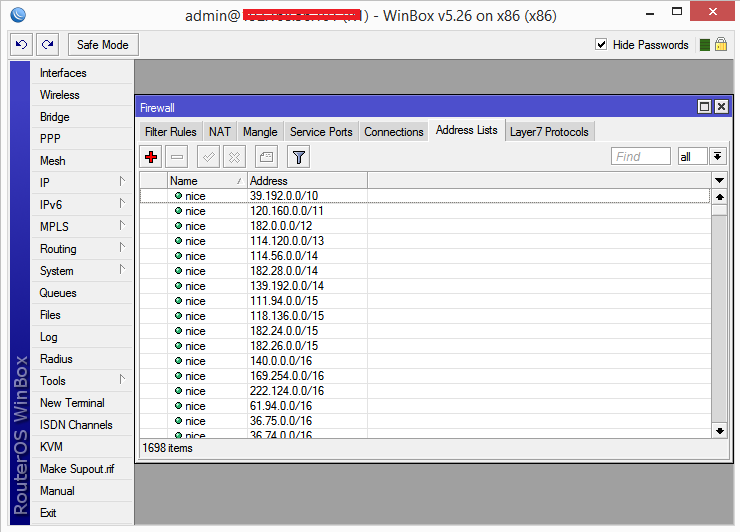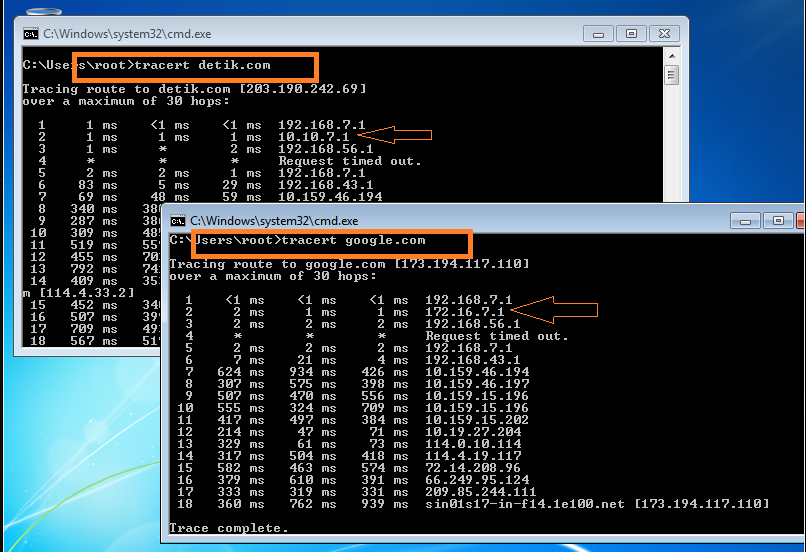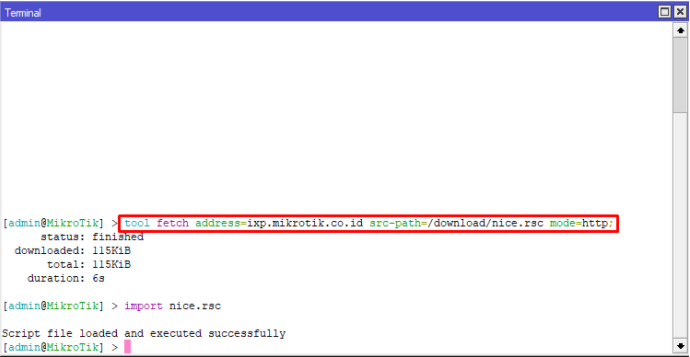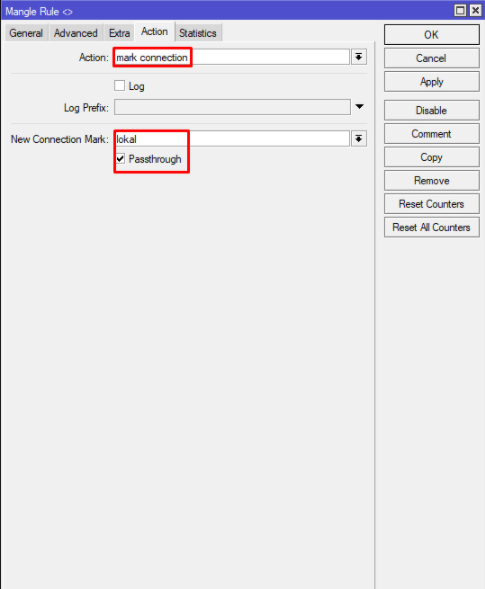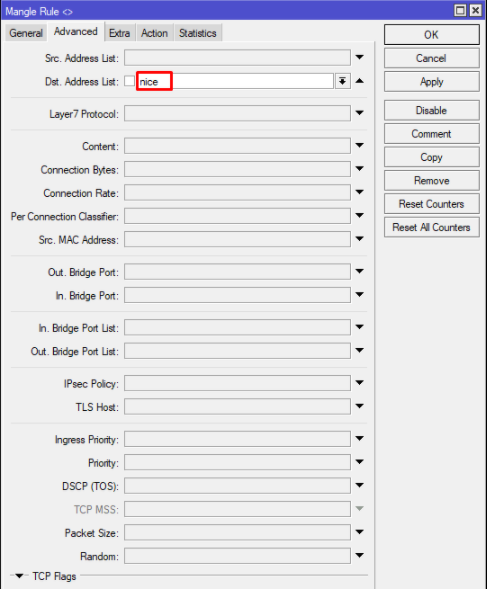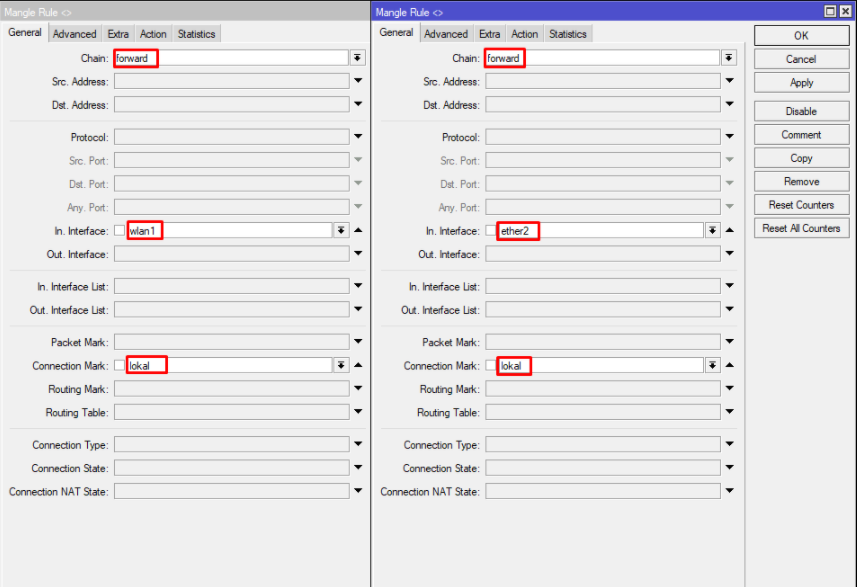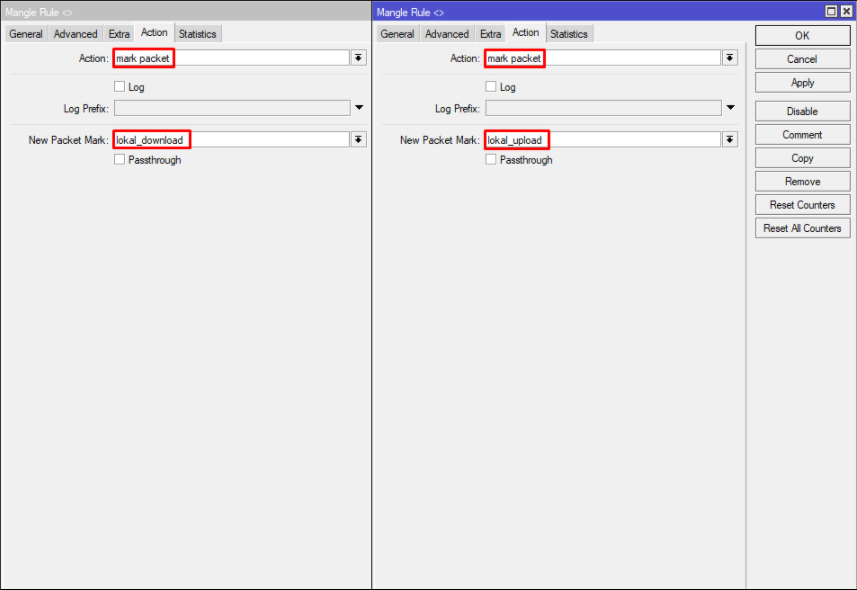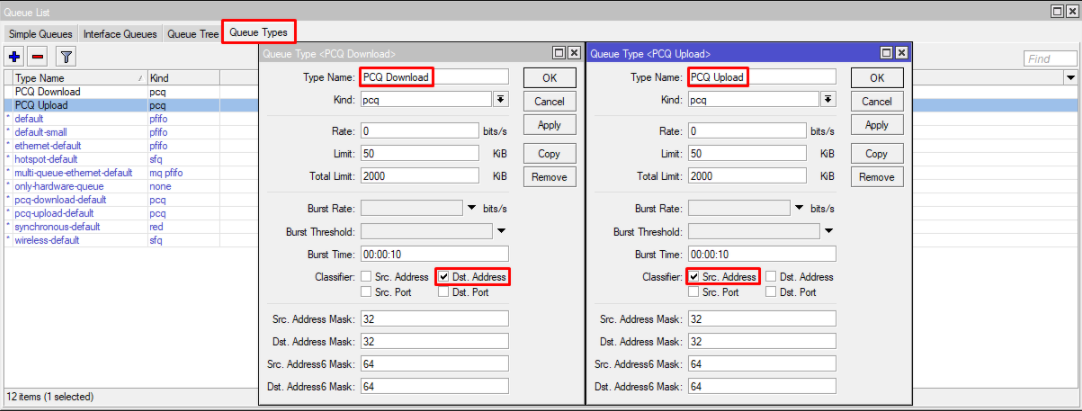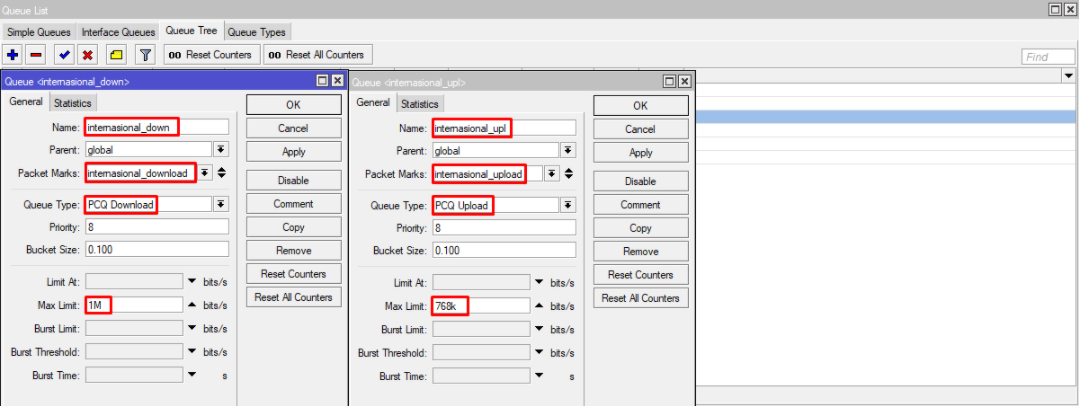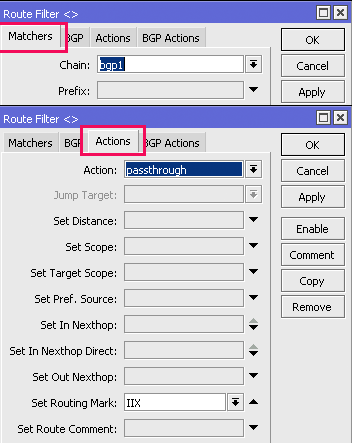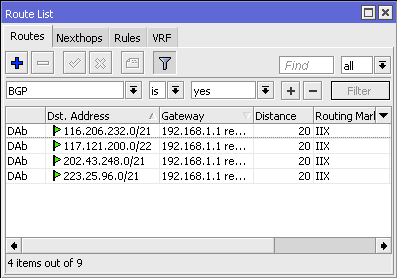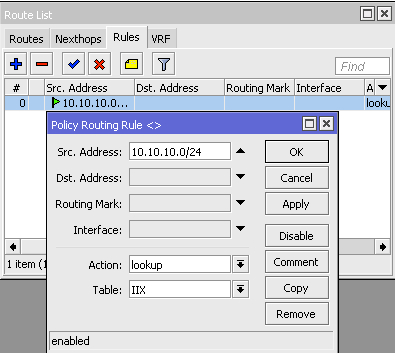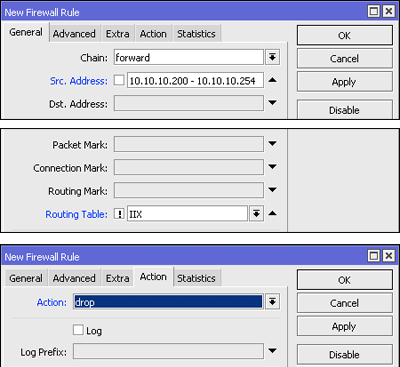In the world of computers, the means of splitting the seperate bandwidth is the maximum data transfer rate across a given local line. Bandwidth can be characterized as network bandwidth, data bandwidth, or digital bandwidth.
The maximum amount of data sent via an internet connection in a certain period of time. Bandwidth is often mistaken for internet speed when it is actually the volume of information that can be sent over a connection in a measured amount of time – calculated in megabits per second (Mbps).
In the world of bandwidth there is what is called local and international bandwidth. But here, we will discuss in detail about local bandwidth, especially for separating local and international bandwidth in various cases. Why should the bandwidth be separated? For more details about bandwidth management, you can read it here.
Before that, we must know the difference between local bandwidth and also international bandwidth.
- Local bandwidth is a site or link in the country or Indonesia. The local bandwidth can be read more thoroughly. Apart from being local, it is actually available too, but the development is often recognized as similar because both are local peering in Indonesia.
- Meanwhile, international bandwidth is foreign sites or links. International bandwidth may be superior in terms of speed.
Without further ado, here’s how to separate local bandwidth from international bandwidth under various conditions.
Check other Access Point Products from NetData:
Table of Contents
Separate Bandwidth local and international bandwidth Mikrotik
- Open New Terminal Type
/ tool fetch address = ixp.mikrotik.co.id src-path = / download / nice.rsc mode = http;
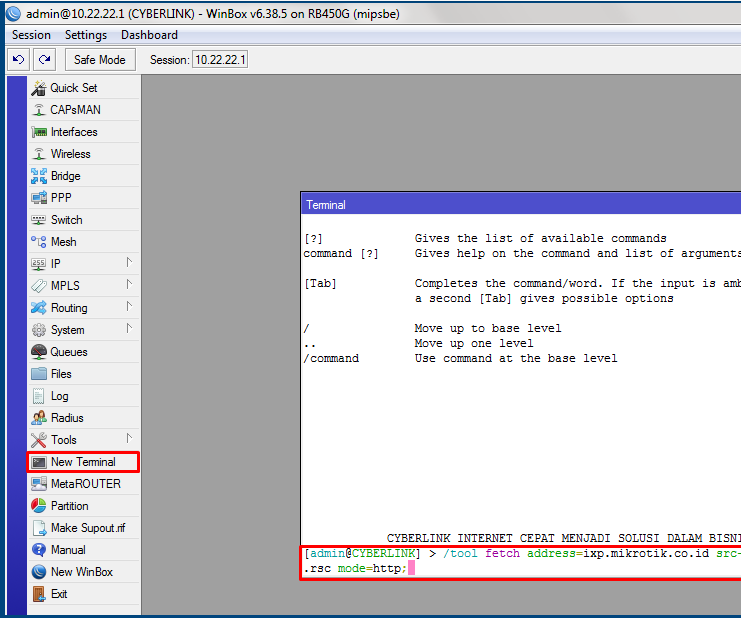
If the status is finished, the configuration is successful.
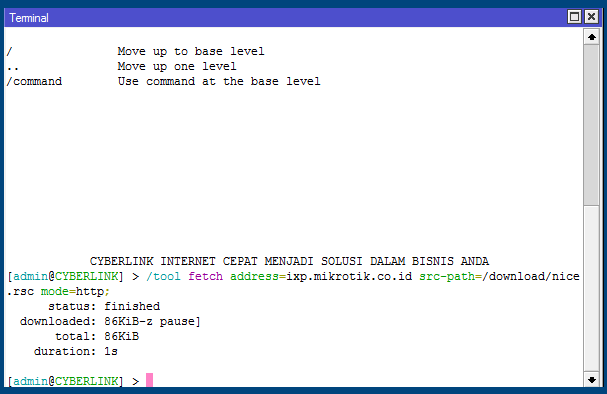
To control the nice.rsc file that we downloaded via the script above, we can see that there is a way to do this by clicking “Files”.
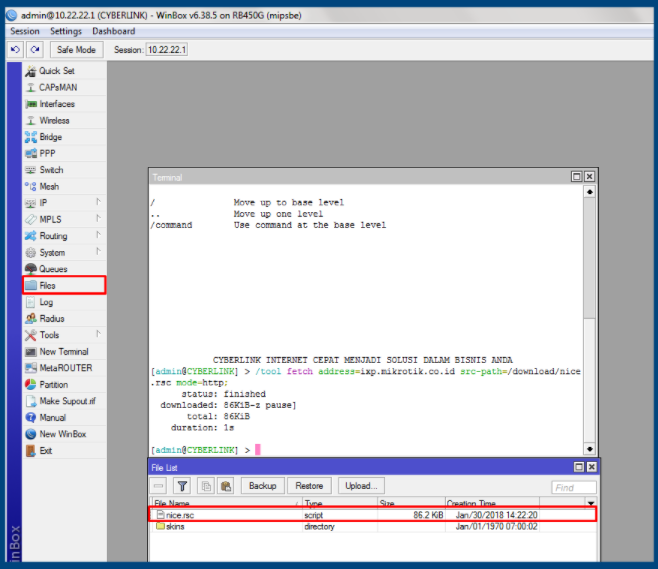
- If there is already a nice.rsc file, then the next step is to type import nice.rsc in the new terminal
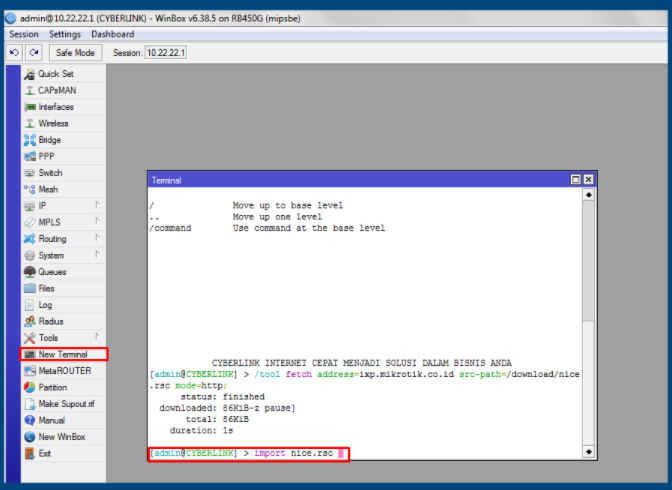 Import the nice.rsc file will be successful if there is a notification like this:
Import the nice.rsc file will be successful if there is a notification like this:
 To find out the nice import results we can go to the menu and click IP-FIREWALL- ADDRESS LIST NICE will be displayed like the following:
To find out the nice import results we can go to the menu and click IP-FIREWALL- ADDRESS LIST NICE will be displayed like the following:
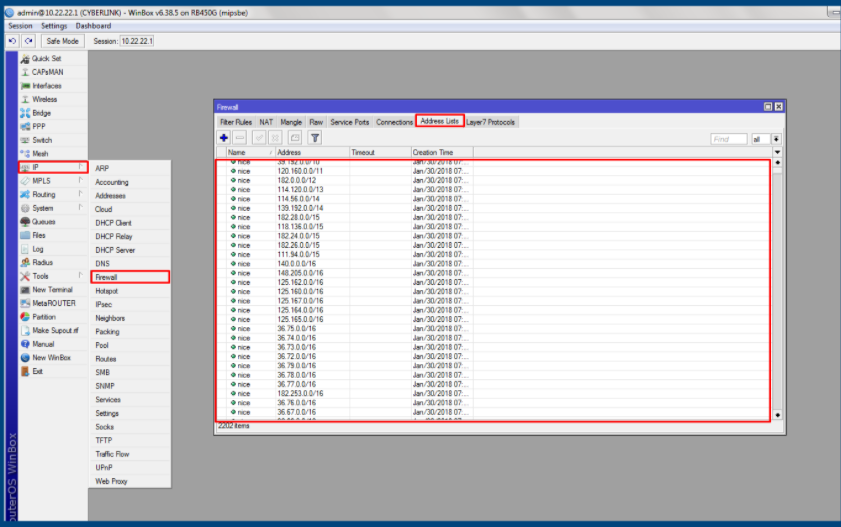
3. The next step is to create some rule mangle, the rule that will be made this time is LOCAL traffic first, click on how to make it to IP menu> FIREWALL> MANGLE> “+”
- General tab.
Chain: Prerouting
- Tab advanced
Src-adress-list: nice
- Tab Action
Action: mark-connection
New-connection-mark: LOCAL
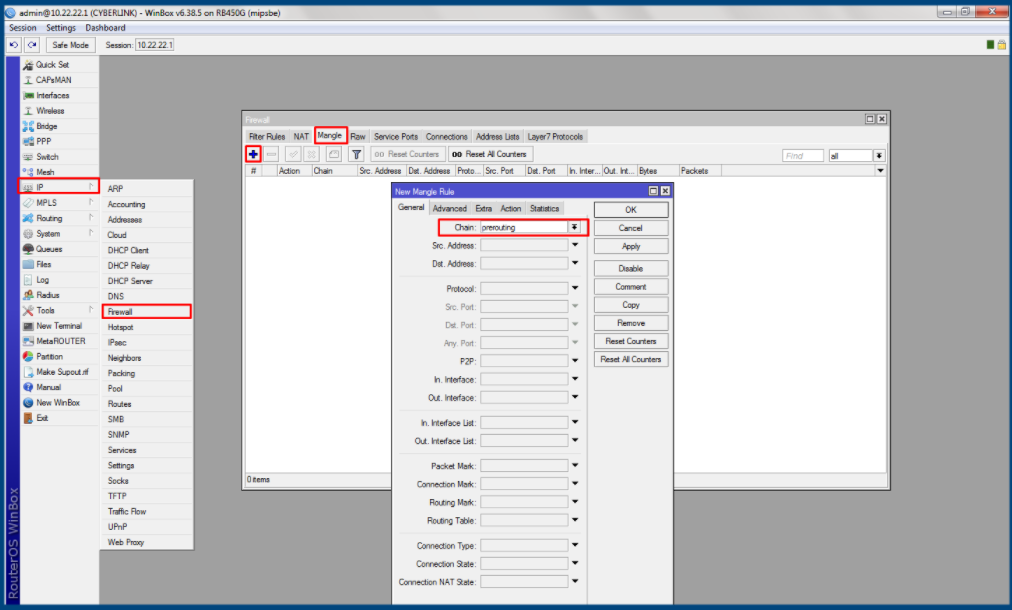
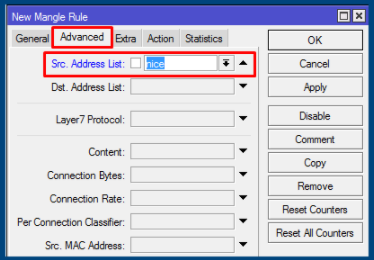
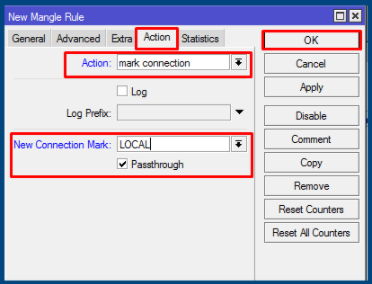
4. Then create a second rule mangle for local traffic, in making this second rule we distinguish between the first rule, for example, first use src-address-list, then in the second rule we use the dst-address-list
- General tab.
Chain: Prerouting
- Tab advanced
dst-adress-list: nice
- Tab Action
Action: mark-connection
New-connection-mark: LOCAL
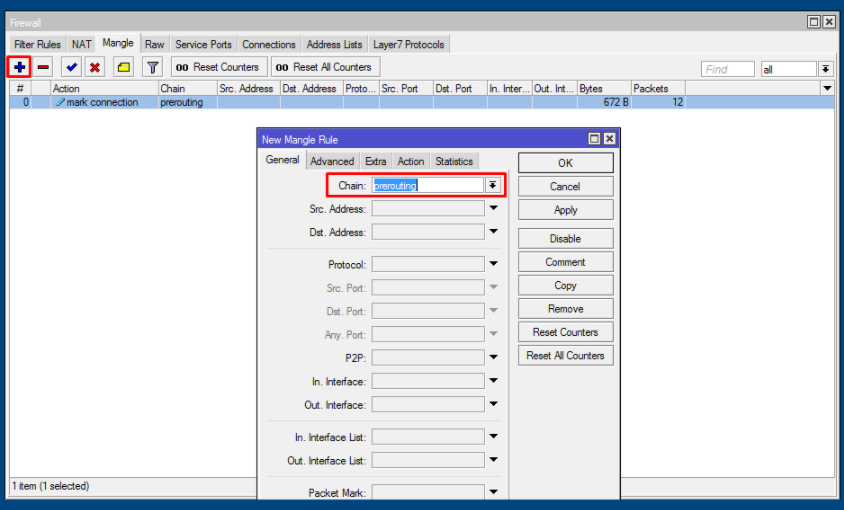
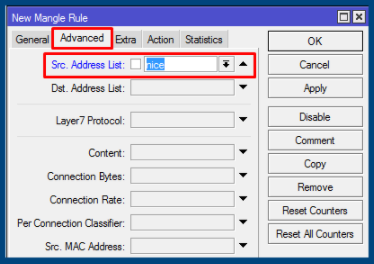
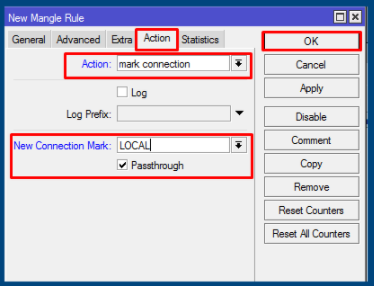
5. Create a third rule mangle for local traffic, In making this rule we generate a packet-mark which will mark the connection above us pack into mark-packets in the third rule, this is the
-
- General tab.
Chain: Prerouting
Connection-mark = LOCAL
- Tab Action
Action: mark-packet
New-packet-mark: LOCAL
Passthrough = no
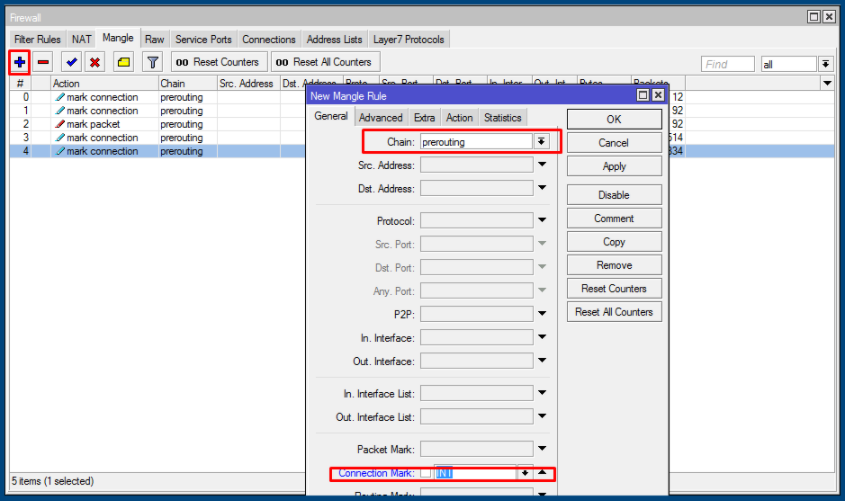
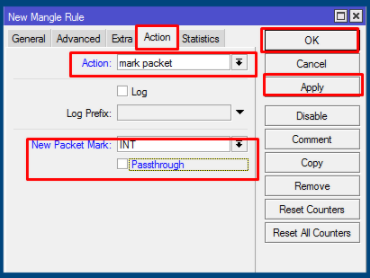
6. When finished causing a rule mangle for local traffic Now we continue to cause mangle for the first INTER rule traffic with the
-
- General tab.
Chain: Prerouting:!
Tab advanced
Src-adress-listnice
- Tab Action
Action: mark-connection
New-connection-mark: INT
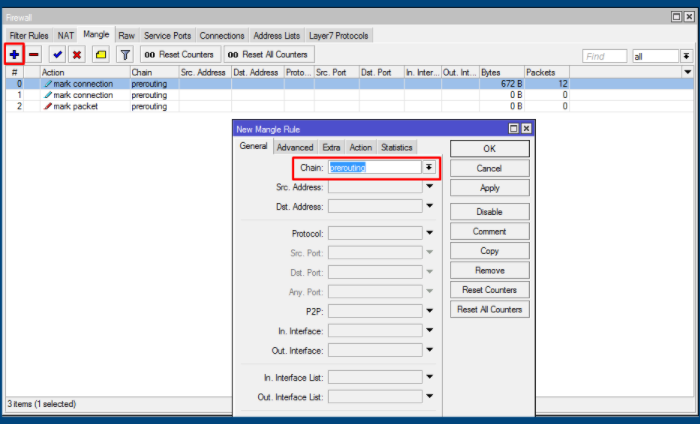
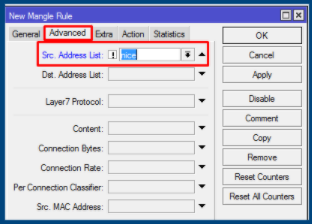
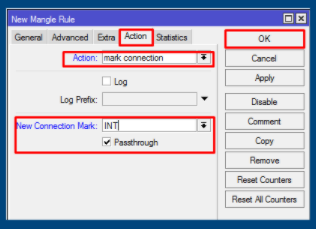
7. Then we continue with the 2nd Rule on INTER traffic with the
-
- General Tab.
Chain: Prerouting:!
Tab advanced
dst-adress-listnice
- Action Tab Action
: mark-connection
New-connection-mark: INT
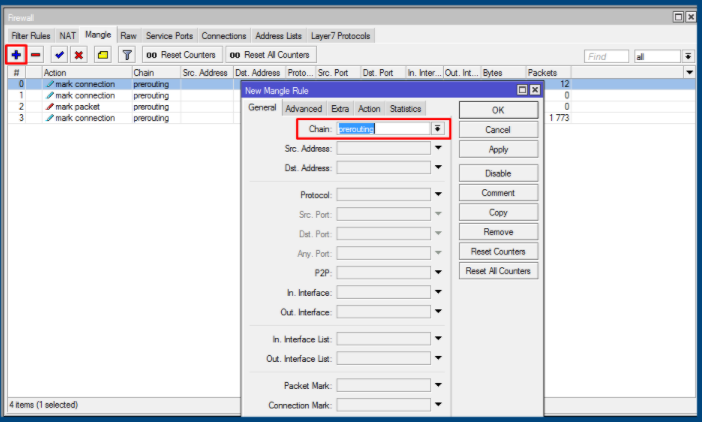
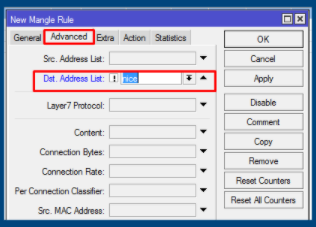
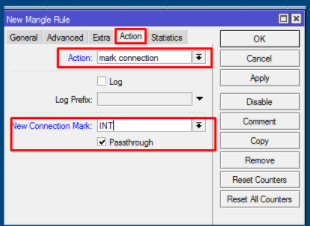
8. When you are finished with mark-connection, continue by creating the last mark-packet rule for INT traffic.
- General tab.
Chain: Prerouting
Connection-mark = INT
- Tab Action
Action: mark-packet
New-packet-mark: INT
Passthrough = no
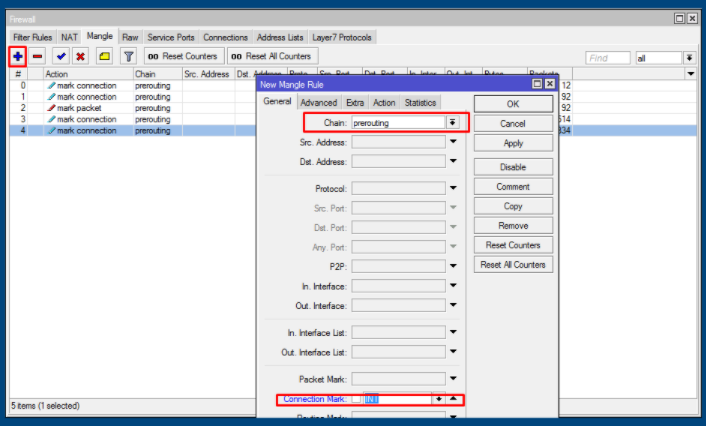
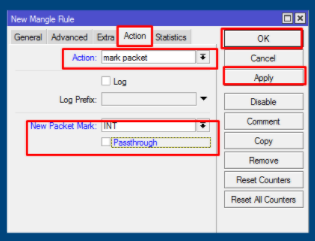
If the local and inter traffic rules have been created, it will appear as shown below, don’t forget to give additional comments.

9. The next step is to create a limiter for local and inter traffic by clicking queues> “+”
-
- General tab
Name: LOCAL
Target: 10.22.22.0/24
Max-limit upload and download = 6M
- Advanced
Package-marks: LOCAL
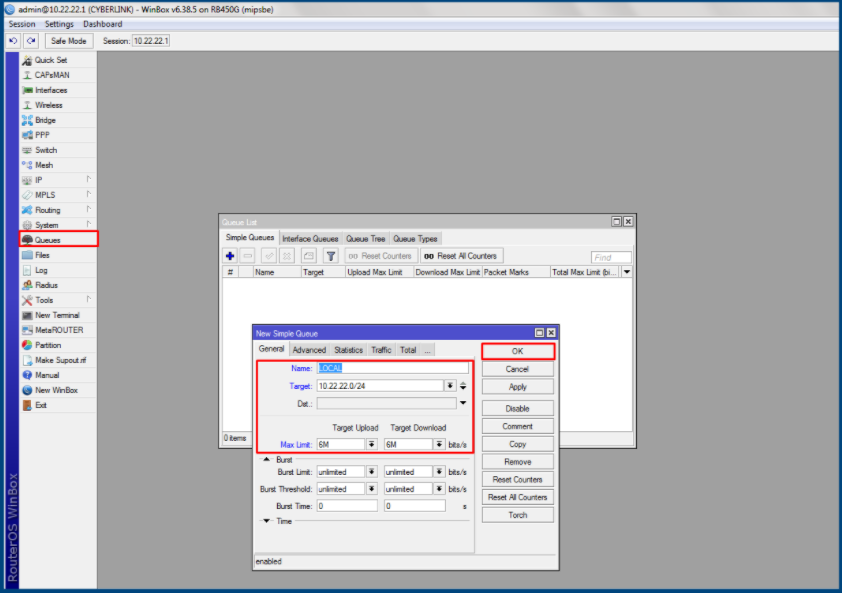
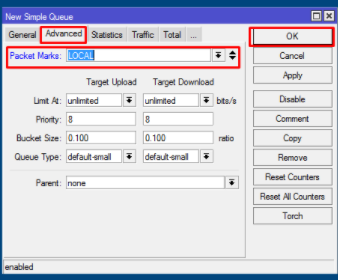
10. Create limiter frOntier
- generalTab
Name: INTER
Target: 10.22.22.0/24
Max-limit upload and download = 3M
- Advanced
Package-marks: INT
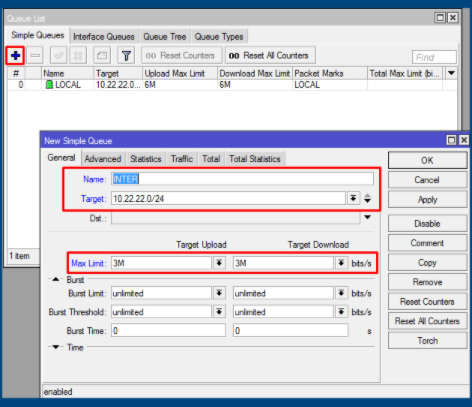
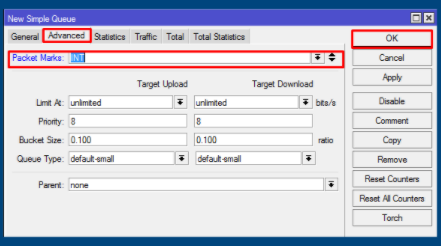 If the configure limiter is complete, the rule limiter will display as follows:
If the configure limiter is complete, the rule limiter will display as follows:
 Finally, try checking configure. Go to youtube.com to find out if the INTER limiter is happening or not, if the limiter is yellow and red then the following graphs work together properly and smoothly, but if the limiter is only green try to see the traffic again, that is a sign the limiter is not running.
Finally, try checking configure. Go to youtube.com to find out if the INTER limiter is happening or not, if the limiter is yellow and red then the following graphs work together properly and smoothly, but if the limiter is only green try to see the traffic again, that is a sign the limiter is not running.
Separating Bandwidth local and international bandwidth of Mikrotik 2 ISP
- You need a list of Indonesian IPs that have been advertised to local how to separate bandwidth by typing the following command to the mikrotik terminal:

- Then import the nice file
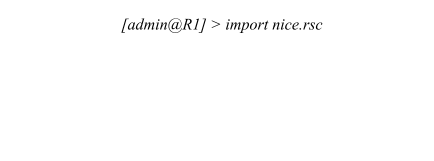
- Next try checking your address-list in the “Firewall” menu and it will appear IP list in Indonesia

Next, create a mangle on the proxy to signify the Iix and international traffic mark routing.

- Now create the default route.

- Because the LAN uses Private IP, don’t forget to make the Nat for the two ISPs

- The last step is to do a tracert from the LAN. This is done to ensure that traffic is being streamed via local and international routes. Perform the following command at the Command Prompt:

Dari hasil tracert bahwa traffic internasional sudah di alirkan ke ISP B, sedangkan untuk traffic lokal di alirkan ke ISP A.
Separating Bandwidth Local and International Bandwidth Mikrotik Queue Tree
- Download the nice.rsc file first. Download with the command tool fetch address = ixp.mikrotik.co.id src-path = / download / nice.rsc mode = http ;. After that you can import the file.

- Create rules on IP firewall mangle, create local rules by forward chain and ds-address-list using nice with the file that was downloaded earlier. And the action used is mark-connection with a local name.



- Use two packet rules, namely download and upload using the mark-packet action and the connection mark is directed to the local rule, for those that are downloaded we point the in.interface point to wlan1 (internet connection) and for those who upload, point in. on ether2 (LAN)


- Create a rule that leads to international connections, similar to local rules, the difference here is that international does not use dst-address-list because nice.rsc is only registered with the local IP address
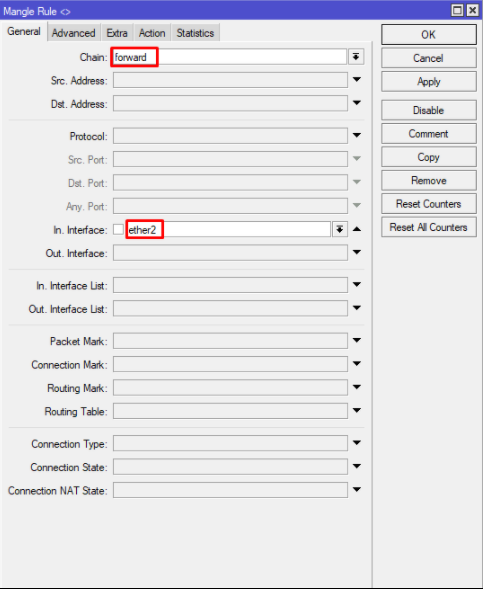
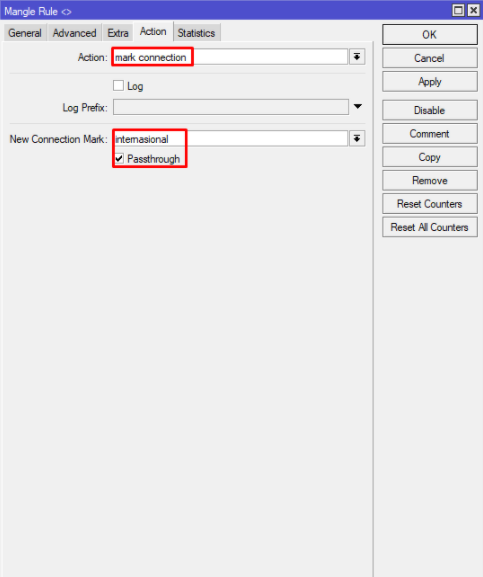
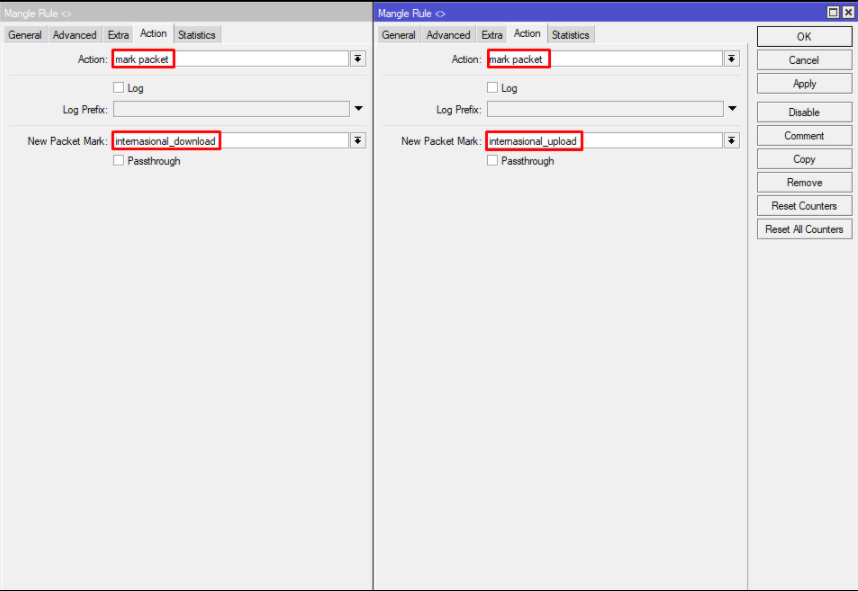
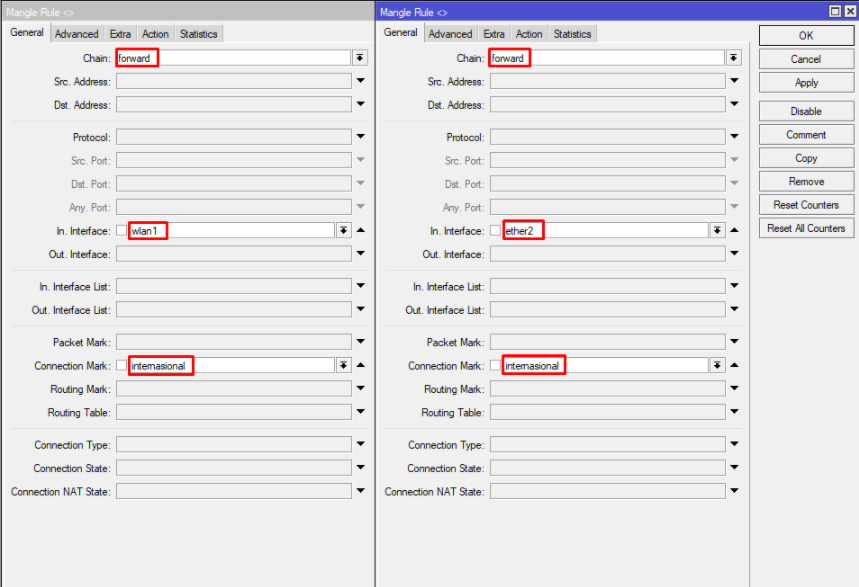
- Create packets that lead to the international rule, the same way as local by creating packets to separate the upload bandwidth and download bandwidth.
- To do this, create two rules that are used to separate the two types of bandwidth.
Download bandwidth we point in.interface at WLAN1 (internet connection) and upload bandwidth we point in.interface at ether2 (LAN) which leads to the client - The rules that have been made will be registered in the IP firewall mangle, then separate between local and international.
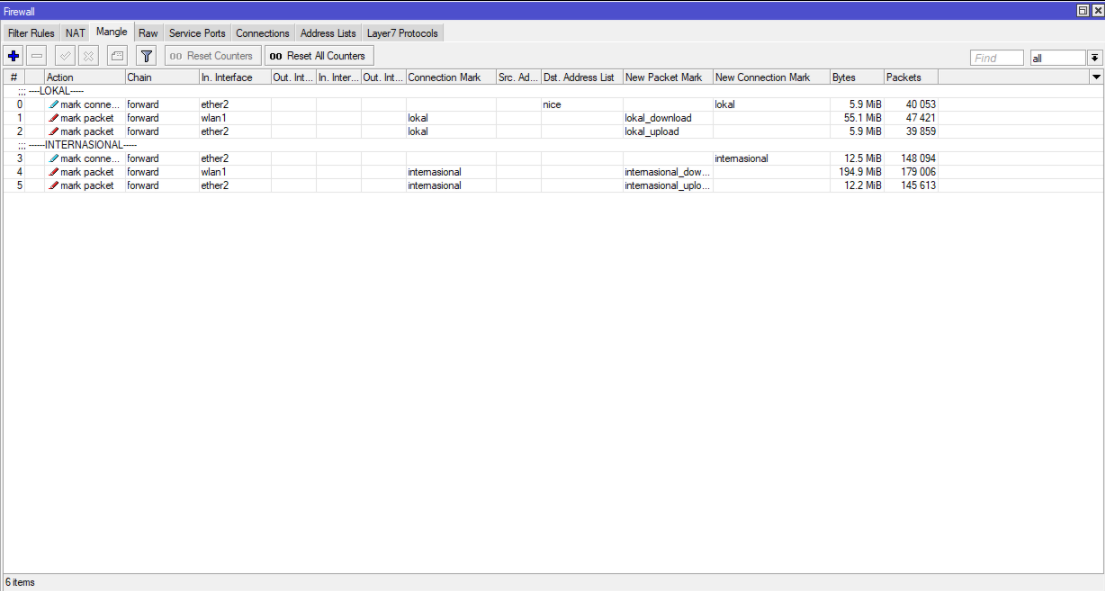
- Enter the Queue, but first create a queue type. Differentiate between download and upload, we make pcq type
- PCQ Download, the classifier used is dst.address
- PCQ Upload, the classifier used is src.address.

- Enter the Queue Tree menu, add rules for local downloads and local uploads. To download, give 1Mb bandwidth and upload 768Kb.
- Packet Marks enter the packet rule that was created in the firewall mangle
- Queue Type enter the queue type that was created in the queue type.
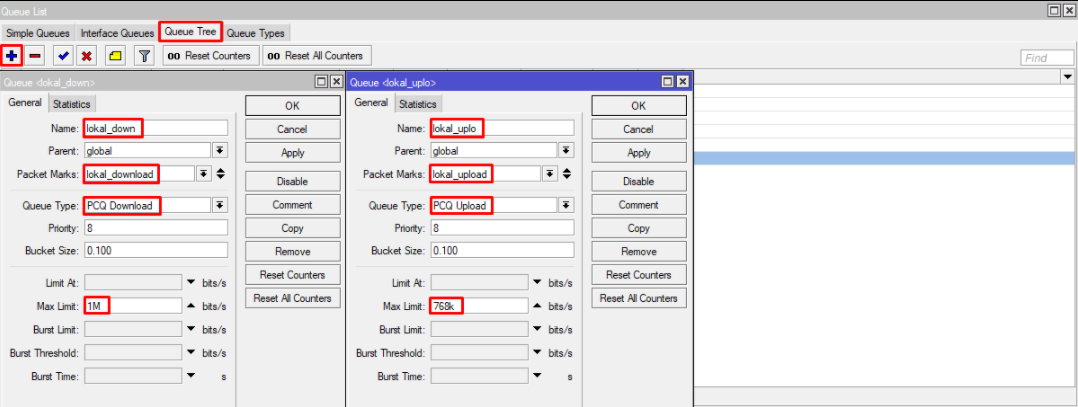
- After that, create a rule on the queue to separate the download bandwidth from the international bandwidth.

- The last step is to test, the method is to use the queue that has been created. But beforehand try doing a speedtest on a web browser.In essence, if a speedtest is carried out with an international server, the international queue type can run, and vice versa if a speedtest is carried out with an Indonesian server, the local queue type can run.
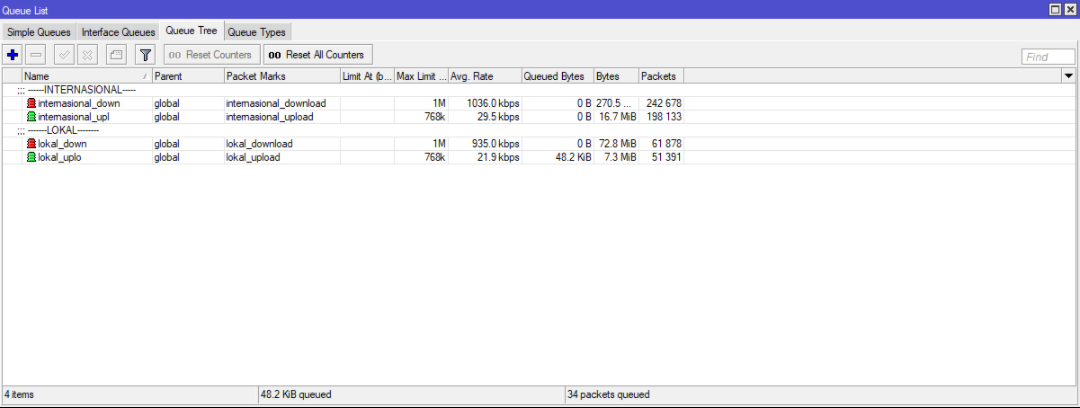
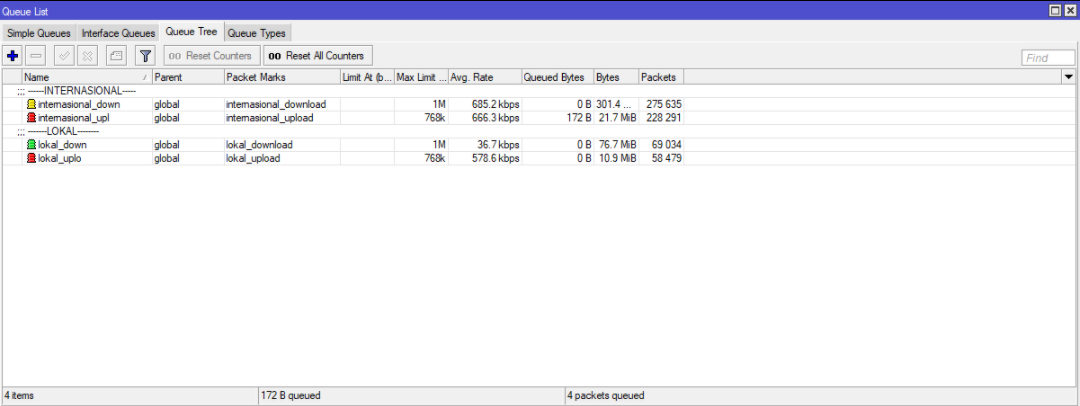
Separating Bandwidth local and international bandwidth for Mikrotik BGP.
- The first thing to note is that it already has a topology. Once formed and along with the BGP Peer, the client router will get routing information using the Dab flag.
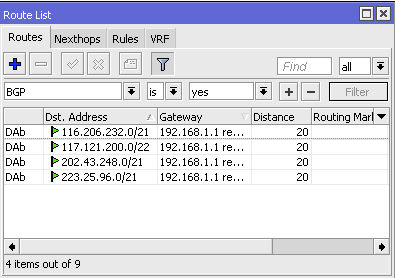
- The router has automatically entered the main routing table. Enter the BGP routing into the routing

- to set the Routing Filter on the BGP Peer use:

-
ThenAll DAb on the Router List will have a routing mark = IIX or local type bandwidth

- Add Route Rule with src-address = IP LAN as follows:

- Next is to set a Firewall Matcher Routing Table. For example, you will manage to only be able to access local websites, then you can add a firewall rule like this:

How to Separate Local and International Bandwidth in Mikrotik
That’s how to separate local and international bandwidth using a Mikrotik router. All of them do have a variety of different functions. But maybe this is very useful for the use of the internet in a company or in an agency such as a school, government office, or others.
Mark routing is very useful, for those of you who have 2 upstream links to gain access through a specific gateway connection point.
Sometimes 2 internet connections have different settings. One tends to be fast on the local bandwidth, while the other is on the international bandwidth. Therefore, there is a need for optimization like the various tutorials above.
Netdata provides professional Bandwidth Management services so you don’t have to bother anymore. Get attractive offers for Bandwidth Management services from Netdata here.
![]()


